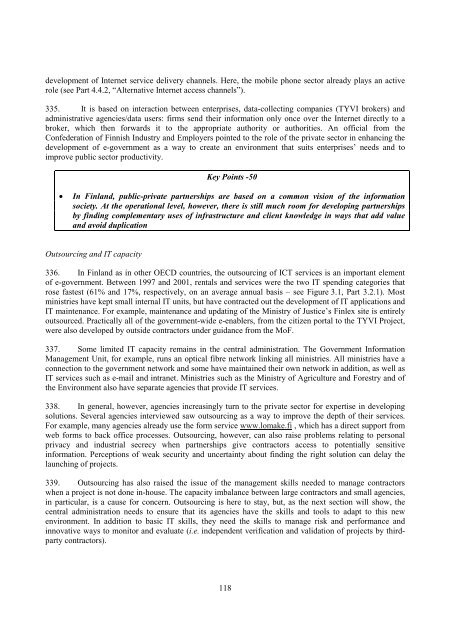e-GOVERNMENT IN FINLAND - ePractice.eu
e-GOVERNMENT IN FINLAND - ePractice.eu
e-GOVERNMENT IN FINLAND - ePractice.eu
Create successful ePaper yourself
Turn your PDF publications into a flip-book with our unique Google optimized e-Paper software.
development of Internet service delivery channels. Here, the mobile phone sector already plays an active<br />
role (see Part 4.4.2, “Alternative Internet access channels”).<br />
335. It is based on interaction between enterprises, data-collecting companies (TYVI brokers) and<br />
administrative agencies/data users: firms send their information only once over the Internet directly to a<br />
broker, which then forwards it to the appropriate authority or authorities. An official from the<br />
Confederation of Finnish Industry and Employers pointed to the role of the private sector in enhancing the<br />
development of e-government as a way to create an environment that suits enterprises’ needs and to<br />
improve public sector productivity.<br />
Key Points -50<br />
x In Finland, public-private partnerships are based on a common vision of the information<br />
society. At the operational level, however, there is still much room for developing partnerships<br />
by finding complementary uses of infrastructure and client knowledge in ways that add value<br />
and avoid duplication<br />
Outsourcing and IT capacity<br />
336. In Finland as in other OECD countries, the outsourcing of ICT services is an important element<br />
of e-government. Between 1997 and 2001, rentals and services were the two IT spending categories that<br />
rose fastest (61% and 17%, respectively, on an average annual basis – see Figure 3.1, Part 3.2.1). Most<br />
ministries have kept small internal IT units, but have contracted out the development of IT applications and<br />
IT maintenance. For example, maintenance and updating of the Ministry of Justice’s Finlex site is entirely<br />
outsourced. Practically all of the government-wide e-enablers, from the citizen portal to the TYVI Project,<br />
were also developed by outside contractors under guidance from the MoF.<br />
337. Some limited IT capacity remains in the central administration. The Government Information<br />
Management Unit, for example, runs an optical fibre network linking all ministries. All ministries have a<br />
connection to the government network and some have maintained their own network in addition, as well as<br />
IT services such as e-mail and intranet. Ministries such as the Ministry of Agriculture and Forestry and of<br />
the Environment also have separate agencies that provide IT services.<br />
338. In general, however, agencies increasingly turn to the private sector for expertise in developing<br />
solutions. Several agencies interviewed saw outsourcing as a way to improve the depth of their services.<br />
For example, many agencies already use the form service www.lomake.fi , which has a direct support from<br />
web forms to back office processes. Outsourcing, however, can also raise problems relating to personal<br />
privacy and industrial secrecy when partnerships give contractors access to potentially sensitive<br />
information. Perceptions of weak security and uncertainty about finding the right solution can delay the<br />
launching of projects.<br />
339. Outsourcing has also raised the issue of the management skills needed to manage contractors<br />
when a project is not done in-house. The capacity imbalance between large contractors and small agencies,<br />
in particular, is a cause for concern. Outsourcing is here to stay, but, as the next section will show, the<br />
central administration needs to ensure that its agencies have the skills and tools to adapt to this new<br />
environment. In addition to basic IT skills, they need the skills to manage risk and performance and<br />
innovative ways to monitor and evaluate (i.e. independent verification and validation of projects by thirdparty<br />
contractors).<br />
118
















